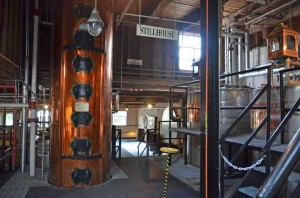Whiskey History: Aeneas Coffey
By Richard Thomas
Even among whiskey enthusiasts, surprisingly few know the name “Aeneas Coffey,” the Irish inventor who could be described as the Thomas Edison of the industry. Sometimes this is even the case when Coffey’s landmark contribution is referred to under his own name, and despite the fact that most of the world’s whiskey industry is heavily dependent upon the piece of equipment that bears his name.
From Taxman To Inventor
Born in France in 1780 to Irish parents, Aeneas Coffey returned to Ireland to attend Trinity College. After finishing his education, he found work in the tax office, married, started a family, and eventually rose to the post of Inspector General of Excise in Ireland. He left the service of the British Crown in 1824.
Between his Dublin education and his work as a taxman, Coffey had ample opportunity to observe the design and workings of whiskey stills, as Ireland was the world’s leading producer of whiskey in the 19th Century, and Dublin was at the center of that global industry. This was how he became familiar with a still design differing from the traditional copper pot alembic still commonly used in Ireland, the continuous, or column, still. First patented by a Cork County distillery in 1822, the column still remained a relatively inefficient piece of equipment, although it pointed the way towards a cheaper and more productive way to distill alcohol. It was that last point that captured Coffey’s imagination.
Coffey made his own modifications to existing column still designs, so as to allow a greater portion of the vapors to re-circulate into the still instead of moving into the receiver with the spirit. The result was more efficient, producing a lighter spirit at higher alcohol content. Coffey patented his design in 1830, and it became the basis for every column still used ever since.
Continuous Distillation
The importance of the efficiency achieved by Coffey’s design, sometimes also called the Coffey Still, for the entire liquor industry cannot be overstated. The best illustration is that prior to Coffey’s invention, most spirits were produced in much the same way that Irish, Scottish and Japanese malt whiskeys are today: distilled two or three times in a process that either requires multiple stills or the laborious and painfully wasteful re-use of one still for the multiple stages of the process.
The column still is divided into two parts, the analyzer and the rectifier. The analyzer circulates steam and alcohol-laden wash through several tiers, functioning in much the same way as multiple pot stills stacked one atop the other. The wash is then transferred to the second part, the rectifier, where it is condensed to a set strength. Even early versions of Coffey’s design were capable of making solutions of 60% alcohol, higher than the norm for double distillation at the time, and modern versions can achieve nearly 96% abv.

(Credit: Joana Thomas
Coffey’s still design was enormously popular with most of the world liquor industry, and was rapidly embraced everywhere except the country of its origin. Ireland dominated the world whiskey trade at the time, and Irish distillers saw little reason to embrace Coffey’s column still, which was thought to produce an inferior and less flavorful product.
To a certain extent whiskey made in a column still is less flavorful, but also smoother, and this is precisely because of the still’s efficiency. By way of comparison, copper pots leave more trace elements behind in the whiskey, elements that contribute both to the flavor and to the harshness of the liquid.
With these factors in mind, the Irish industry stuck with their signature pot still whiskey, produced using a mix of malted and unmalted barley and in a modified pot still. Coffey was forced to market his design across the Irish Sea in Scotland, where it was used to make the grain whisky. Coffey’s still became the foundation for the major blended Scotch brands that dominate the global whiskey trade today, and it also became the predominant design in the American whiskey industry as well. Eventually the Irish whiskey industry was forced to embrace Coffey’s invention and grain whiskey, but only after the design and its products had contributed to that industry’s decline and eclipse.





One Comment